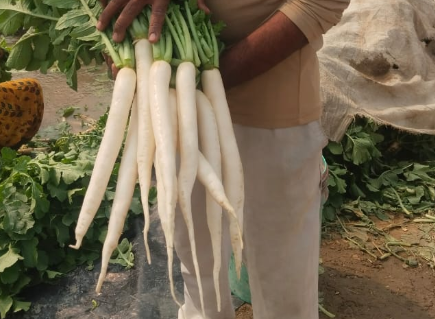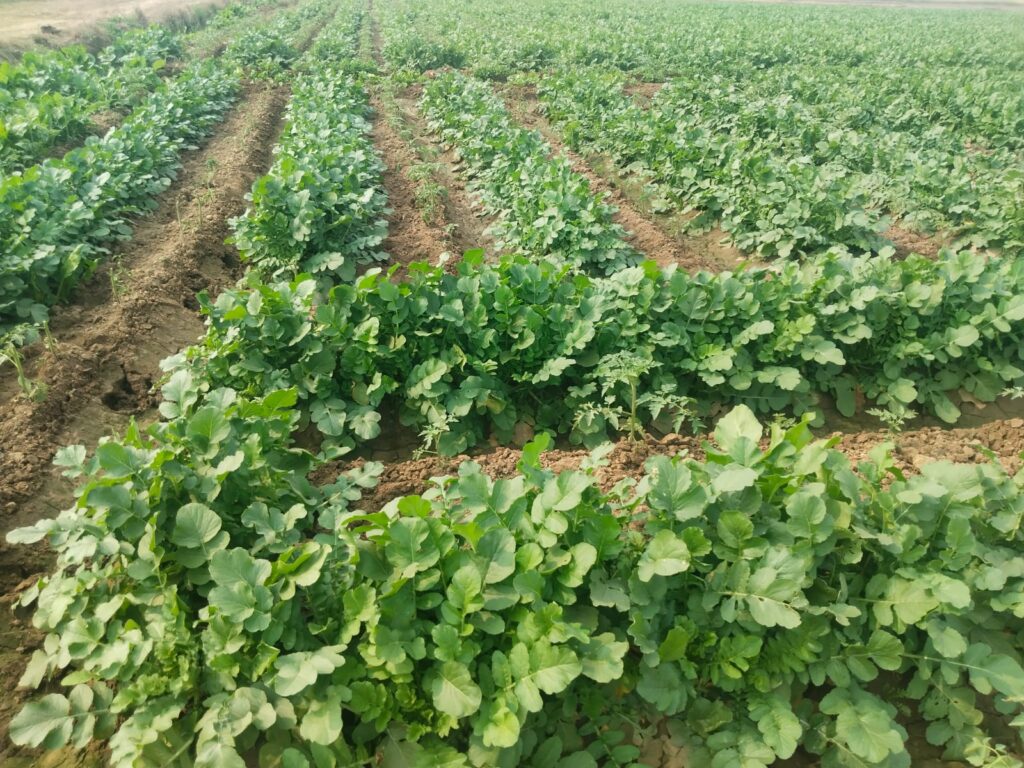Radishes are fast-growing, nutritious root vegetables that are easy to cultivate and require minimal care. Whether you’re a beginner gardener or an experienced farmer, growing radishes can be a rewarding and low-maintenance experience. This guide covers everything you need to know, from choosing the right variety to harvesting your crop.
Choose the Right Variety
There are many radish varieties, each with distinct flavors, colors, and shapes. The most popular types include:
- Red Globe: Classic round red radishes with a mild flavor.
- White Icicle: Long, white radishes with a sharp, peppery taste.
- Daikon: Large, white radishes often used in Asian cuisine, known for their mild flavor.
- Black Spanish: Dark-skinned, spicy-tasting radishes ideal for winter storage.
For quick-growing crops, choose smaller varieties like Cherry Belle or French Breakfast, which mature in about 25-30 days. Larger varieties, such as Daikon, take longer (50-70 days) but offer a greater yield.
Select an Ideal Growing Location
It thrive in the right environment. Here’s what to look for:
- Sunlight: need at least 6 hours of direct sunlight per day.
- Soil Type: Well-drained, loose, and loamy soil is best. Sandy loam or loamy soil is ideal, with a pH between 5.5 and 6.8.
- Temperature: These Crops are prefer cooler temperatures, ideally between 50°F and 70°F (10°C to 21°C). High heat can cause them to bolt (flower prematurely) or become tough and woody.
Prepare the Soil
- Clear the Area: Remove any weeds, rocks, or debris from the planting site.
- Loosen the Soil: It Required loose, well-draining soil for proper root development. Use a hoe or garden fork to break up compacted soil.
- Add Organic Matter: Mix in compost or well-rotted manure to improve soil texture and fertility. Avoid adding too much nitrogen, as this encourages leafy growth instead of root development.


Sowing Seeds
- Planting Depth: Sow radish seeds about ½ inch (1.25 cm) deep.
- Row Spacing: Space rows 12 inches (30 cm) apart. Within the rows, plant seeds 1-2 inches (2.5-5 cm) apart.
- Thinning: Once seedlings emerge and have a few leaves, thin them to 2-3 inches (5-7.5 cm) apart to allow the roots to grow properly.
- Direct Seeding: Radishes are easy to grow from seeds directly sown in the soil, and they germinate quickly—usually within 3-10 days.
Watering and Moisture Management
Radish need consistent moisture to grow well, but they do not tolerate soggy soil. Here’s how to manage watering:
- Water Regularly: Keep the soil evenly moist but not waterlogged. Water deeply once or twice a week, depending on weather conditions.
- Avoid Overwatering: Shallow watering can result in small, underdeveloped roots. Water deeply to encourage strong root growth.
Weed Control
Weeds compete with your radishes for space and nutrients. To keep them under control:
- Mulch: Apply a layer of organic mulch around your radishes to retain moisture and suppress weeds.
- Hand-Weeding: Be careful when weeding to avoid disturbing the shallow roots of the radishes.
Pest and Disease Management
While radishes are relatively pest-resistant, some common issues may arise:
- Aphids: These small insects can damage leaves. Use insecticidal soap or encourage natural predators like ladybugs.
- Flea Beetles: These tiny beetles can create holes in leaves. Protect seedlings with row covers or apply diatomaceous earth.
- Clubroot: This soilborne disease causes deformed roots. Rotate crops each year to reduce the risk of clubroot.
Harvesting Radishes
Radishes grow quickly, so it’s important to harvest them at the right time:
- Maturity: These Crops are typically ready for harvest in 25-30 days for smaller varieties, and 50-70 days for larger types.
- Signs of Readiness: When the root has reached about 1 inch (2.5 cm) in diameter and is visible above the soil, it’s time to harvest. Pull gently on the tops of the greens to check the size of the root.
- Harvesting Method: Loosen the soil around the crop with a garden fork and gently pull them from the ground.
Post-Harvest Care
- Cleaning: Remove soil from the crop by brushing them gently. Trim the tops to about 1-2 inches above the root.
- Storage: It can be stored in the refrigerator for up to a week. For long-term storage, you can pickle or ferment them.
Successive Planting for Continuous Harvest
These Crops are great for succession planting. By sowing seeds every 7-10 days, you can enjoy a continuous supply of fresh radishes throughout the growing season. This is particularly beneficial in cooler climates where radishes grow quickly.
Additional Tips for Success
- Spacing is Key: Avoid overcrowding radish plants. Proper spacing ensures that the roots have enough room to grow to full size.
- Rotate Crops: To prevent soil depletion and reduce pest and disease risks, rotate radish crops each year.
- Watch for Bolting: It may bolt (flower) in hot weather, causing the roots to become tough and bitter. Harvest early if you notice signs of bolting.
- Soil Health: Add compost each season to improve soil health and keep your radish crop thriving.
Common Challenges and How to Overcome Them
- Hot Weather: These Crops are not perform well in hot weather. If you’re in a warm climate, plant in early spring or late fall.
- Too Much Nitrogen: Excess nitrogen can cause excessive leafy growth at the expense of root development. Use fertilizers sparingly.
By following these steps, you’ll be able to grow a successful crop—whether you’re gardening in your backyard or managing a larger farming operation. Radishes are a fantastic crop for beginners and seasoned gardeners alike, offering quick harvests and minimal upkeep.